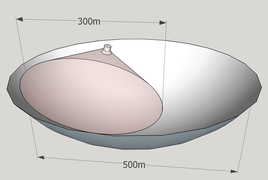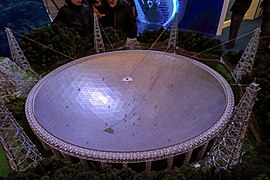FAST (radio telescope)
|
Telescope FAST (radio telescope) 五 百米 口径 球面 射 电 望远镜 |
|
|---|---|

|
|
| ALMOST in the construction phase, 2015 | |
| Type | Radio telescope |
| Location | Pingtang , Guizhou , China |
| Geographic coordinates | 25 ° 39 '9 " N , 106 ° 51' 24.1" E |
| wavelength | 70 MHz to 3 GHz (as of 2019) |
| Aperture | 300 m
|
| construction time | 2011-2016 |
| Installation | July 2016 to September 2019 |
| Specialty | Largest radio telescope in the world in terms of area |
FAST ( Chinese 五百米口徑球面射電望遠鏡 / 五百米口径球面射电望远镜 , Pinyin wǔbǎi mǐ kǒujìng qiúmiàn shèdiàn wàngyuǎnjìng , English F ive-hundred-meter A perture S pherical radio T elescope ), nickname Tianyan ( 天眼 , tiān yǎn - "Celestial Eye") is a radio telescope in Kedu in Guizhou Province in southwest China . With a primary mirror diameter of around 520 meters, it is the world's largest radio telescope. FAST collects a particularly large amount of electromagnetic radiation for optical imaging and enables short exposure times . The term "FAST" (in German: fast ) is therefore an apronym .
After three years of reviews, the technical acceptance took place in April 2019. After that, FAST was initially available to domestic astronomers in trial operation, and from September 2019 also to foreign astronomers. The final acceptance and official commissioning took place on January 11, 2020.
Building history
The telescope was erected in a karst hollow from 2011 . The 9,110 residents within a five kilometer radius were relocated to avoid electromagnetic interference . The construction costs were 1.2 billion yuan , the equivalent of about 160 million euros . Commissioning was estimated at three years and lasted from July 2016 to September 2019. Over a hundred pulsars have already been discovered.
functionality
FAST has a deformable, almost spherical primary mirror that hangs in the natural hollow of the terrain. Only the area of the main mirror that is directed at the sky region to be examined is used to receive the radio waves. This area has a diameter of 300 m and is dynamically deformed into a parabolic mirror to avoid spherical aberration . A receiver located above is positioned in the focus of the parabolic mirror by a rope suspension. This setup enables observations of sky regions up to 40 ° zenith distance without the use of a pivoting mechanism .
The telescope is initially designed for the frequency range from 70 MHz to 3 GHz, later it will work up to 8 GHz. The L-band has an angular resolution of 2.8 arc minutes .
construction
A roughly horizontal tubular space ring is supported by about 70 vertical prismatic masts that compensate for different heights in the terrain. This ring holds a rope grid that is sagging under the force of gravity. This steel wire mesh carries 4450 triangular rigid reflective surface elements ( reflective panels ), which together form an approximately spherical mirror with a 300 m radius of curvature. These triangular panels have a side length of 11 m and consist of a load-bearing tubular space construction on which a grating of about 1 cm grid dimension lies, much smaller than the smallest reflective wavelength of 10 cm. Pull ropes lead from the nodes of the cable network to actuators anchored on the ground for dynamic deformation of the mirror.
The focus cabin is roughly positioned and tends to be oriented in the direction of view by pulling cables from six masts distributed around the bowl. In the cabin there are (initially) 19 detectors with horn antennas on a movable platform. The position of the cabin and detector platform is recorded with six lasers. The opening angle of the detectors limits the effective aperture of the telescope to 300 m. On this surface, which comprises around 1000 nodes and moves with the line of sight, the mirror is brought into a parabolic shape by the actuators. A stroke of 67 cm is sufficient for this. The position of the nodes is recorded with millimeter precision by nine measuring cameras.
- FAST structure
literature
- Rendong Nan et al: The Five-Hundred-Meter Aperture Spherical Radio Telescope (FAST) Project. International Journal of Modern Physics D 20, 2011, doi: 10.1142 / S0218271811019335 , arxiv : 1105.3794 .
- Hans Jürgen Kärcher, Hui Li, Rendong Nan: The steel structure of the 500 m radio telescope FAST. Stahlbau 85, 2016, issue 6, pp. 375–379, doi: 10.1002 / stab.201610385 .
See also
Web links
- Official Website (Chinese)
- Official website (English)
- Five-Hundred Meter Aperture Spherical Radio Telescope (FAST). Cable-Suspended Robot Model and Comparison with the Arecibo Observatory , November 2015. (English)
- DailyMail - Bildbericht von der Baustelle - China is building the world's biggest radio telescope that's the equivalent of 30 football pitches so it can 'listen to the UNIVERSE'. (English)
Individual evidence
- ↑ a b Elizabeth Gibney: Gigantic Chinese telescope opens to astronomers worldwide. Nature News, September 24, 2019, doi: 10.1038 / d41586-019-02790-399 .
- ↑ “中国 天 眼” 通过 国家 验收. In: cnsa.gov.cn. January 13, 2020, accessed January 14, 2020 (Chinese).
- ↑ China to Relocate 9,110 for World's Largest Radio Telescope. China Radio International , February 16, 2016, accessed February 17, 2016 .
- ↑ Xinhua Insight: Installation complete on world's largest radio telescope. In: Xinhua . July 3, 2016, accessed September 8, 2016 .
- ^ Rebecca Morelle: China's colossal radio telescope begins testing. BBC News, September 25, 2016, accessed September 25, 2016 .





